J Sainsbury HRM Report: Guest's Model, Flexibility, and Strategic HRM
VerifiedAdded on 2020/01/23
|18
|4428
|173
Report
AI Summary
This report delves into the realm of Human Resource Management (HRM), examining its core principles and applications within the context of J Sainsbury plc, a major UK supermarket. It explores Guest's model of HRM, outlining its dimensions and strategic implications, and contrasts it with traditional personnel and industrial relations practices. The report also analyzes the role of flexibility in modern organizations, detailing its types and benefits from both employee and employer perspectives. Furthermore, it addresses strategic approaches to HRM, emphasizing the roles of line managers and employees in fostering a productive and engaged workforce. The report covers performance management methods, employee welfare strategies, and the implementation of health and safety regulations, offering a comprehensive overview of HRM practices.
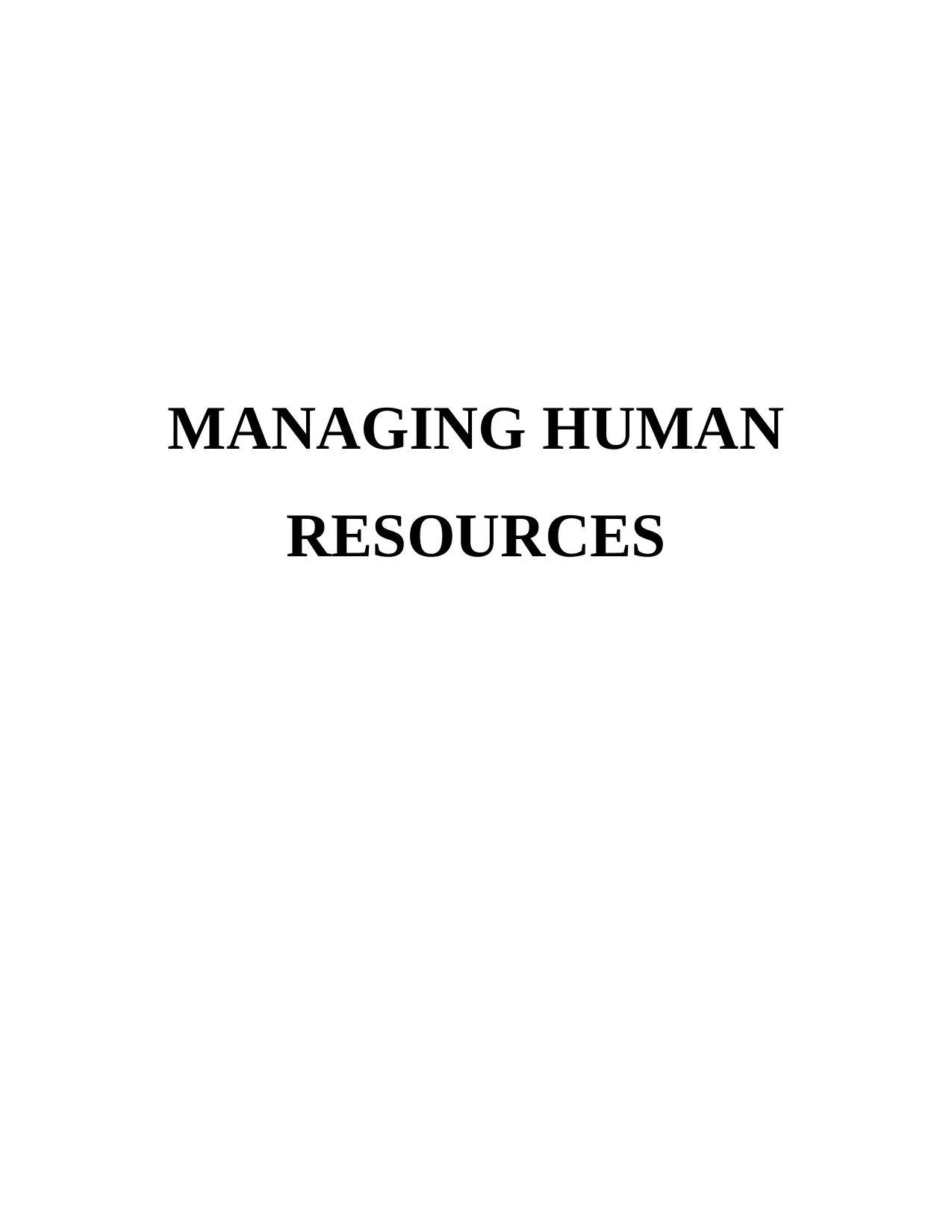
MANAGING HUMAN
RESOURCES
RESOURCES
Paraphrase This Document
Need a fresh take? Get an instant paraphrase of this document with our AI Paraphraser
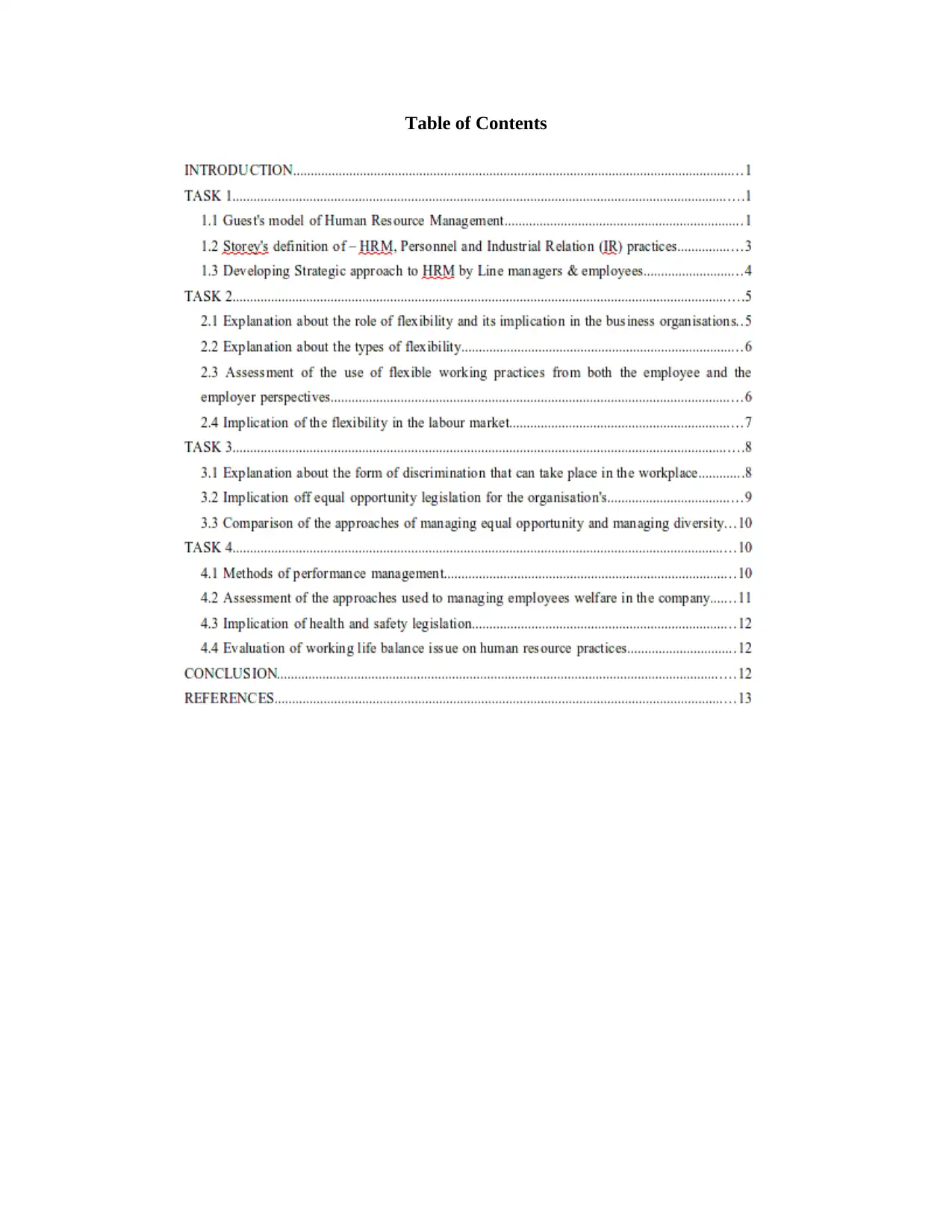
Table of Contents
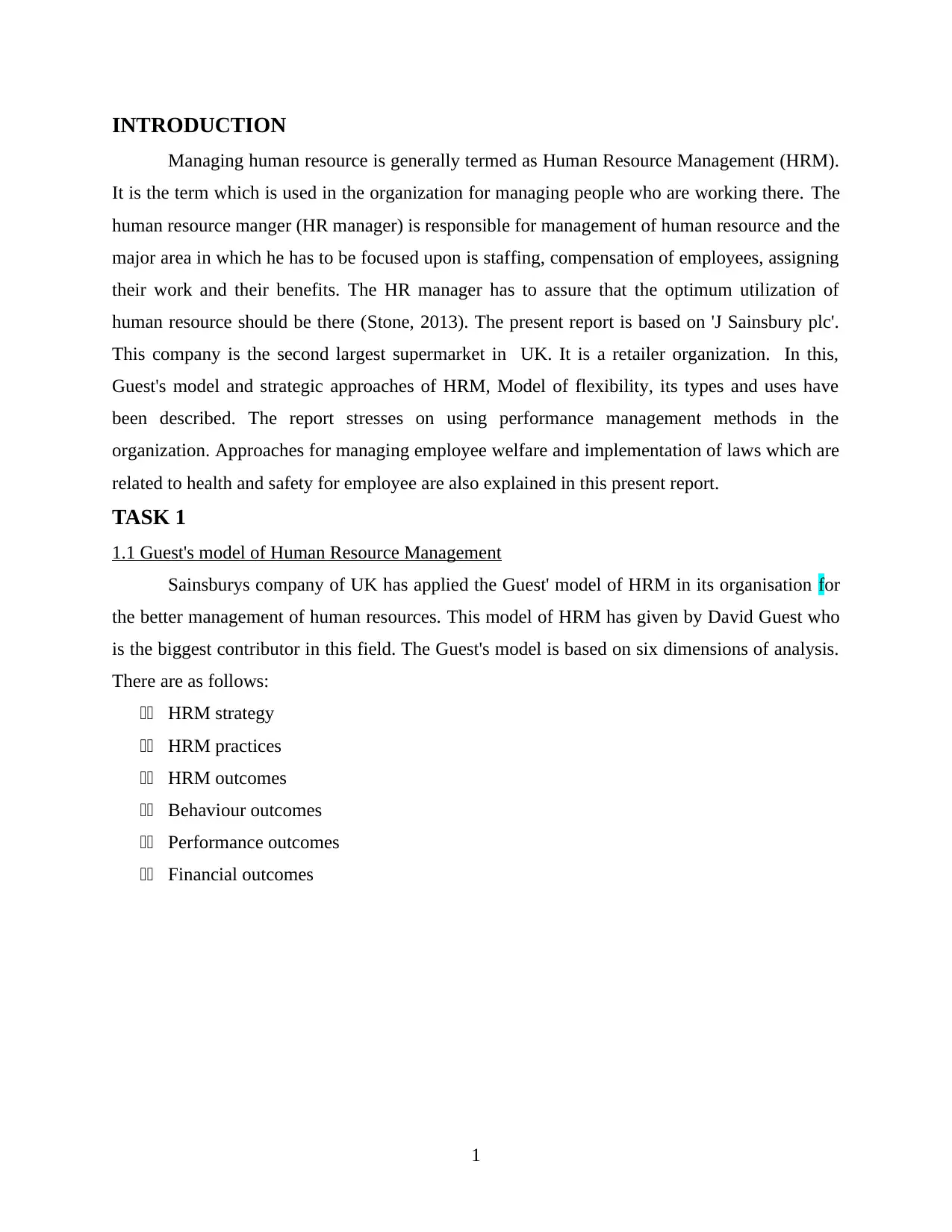
INTRODUCTION
Managing human resource is generally termed as Human Resource Management (HRM).
It is the term which is used in the organization for managing people who are working there. The
human resource manger (HR manager) is responsible for management of human resource and the
major area in which he has to be focused upon is staffing, compensation of employees, assigning
their work and their benefits. The HR manager has to assure that the optimum utilization of
human resource should be there (Stone, 2013). The present report is based on 'J Sainsbury plc'.
This company is the second largest supermarket in UK. It is a retailer organization. In this,
Guest's model and strategic approaches of HRM, Model of flexibility, its types and uses have
been described. The report stresses on using performance management methods in the
organization. Approaches for managing employee welfare and implementation of laws which are
related to health and safety for employee are also explained in this present report.
TASK 1
1.1 Guest's model of Human Resource Management
Sainsburys company of UK has applied the Guest' model of HRM in its organisation for
the better management of human resources. This model of HRM has given by David Guest who
is the biggest contributor in this field. The Guest's model is based on six dimensions of analysis.
There are as follows:
11 HRM strategy
11 HRM practices
11 HRM outcomes
11 Behaviour outcomes
11 Performance outcomes
11 Financial outcomes
1
Managing human resource is generally termed as Human Resource Management (HRM).
It is the term which is used in the organization for managing people who are working there. The
human resource manger (HR manager) is responsible for management of human resource and the
major area in which he has to be focused upon is staffing, compensation of employees, assigning
their work and their benefits. The HR manager has to assure that the optimum utilization of
human resource should be there (Stone, 2013). The present report is based on 'J Sainsbury plc'.
This company is the second largest supermarket in UK. It is a retailer organization. In this,
Guest's model and strategic approaches of HRM, Model of flexibility, its types and uses have
been described. The report stresses on using performance management methods in the
organization. Approaches for managing employee welfare and implementation of laws which are
related to health and safety for employee are also explained in this present report.
TASK 1
1.1 Guest's model of Human Resource Management
Sainsburys company of UK has applied the Guest' model of HRM in its organisation for
the better management of human resources. This model of HRM has given by David Guest who
is the biggest contributor in this field. The Guest's model is based on six dimensions of analysis.
There are as follows:
11 HRM strategy
11 HRM practices
11 HRM outcomes
11 Behaviour outcomes
11 Performance outcomes
11 Financial outcomes
1
⊘ This is a preview!⊘
Do you want full access?
Subscribe today to unlock all pages.

Trusted by 1+ million students worldwide
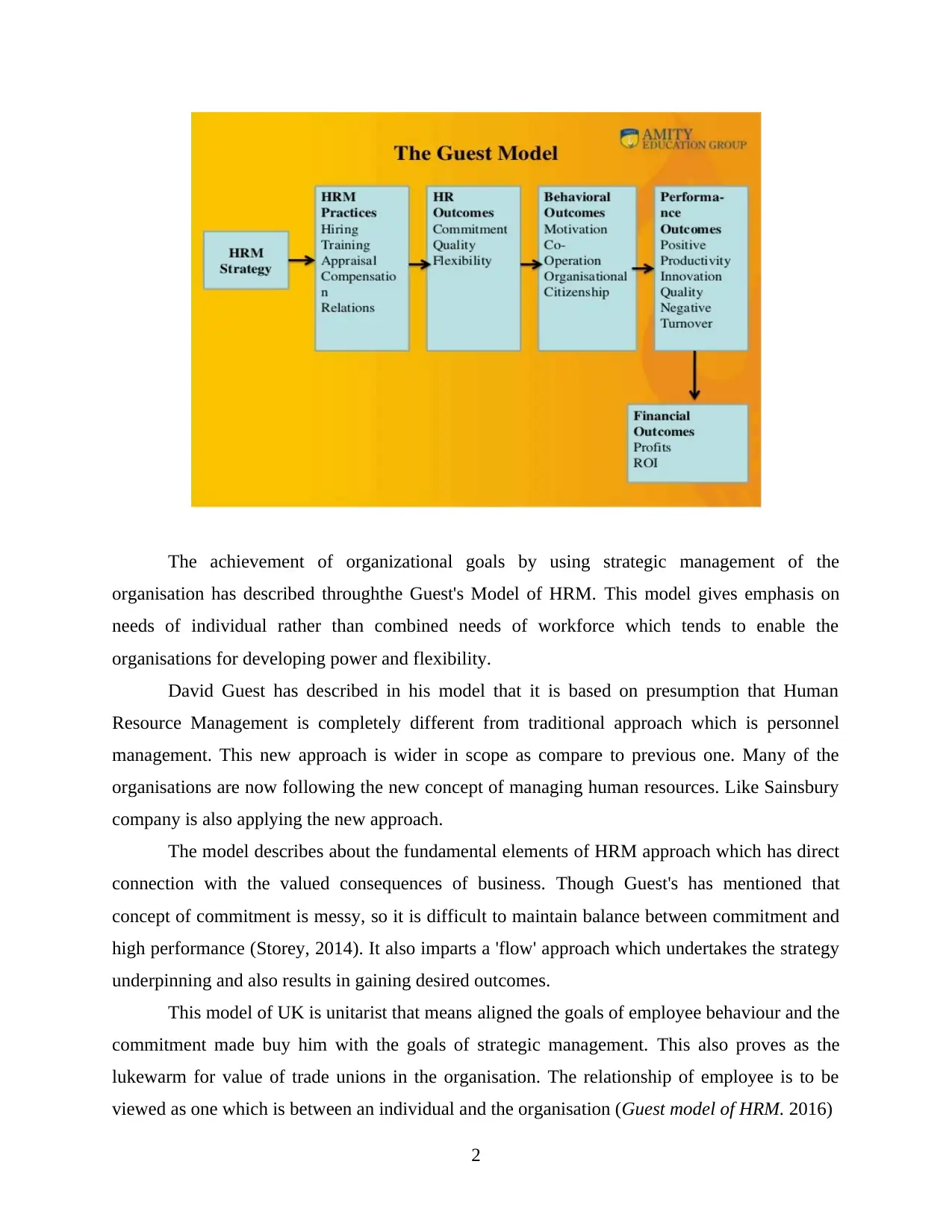
The achievement of organizational goals by using strategic management of the
organisation has described throughthe Guest's Model of HRM. This model gives emphasis on
needs of individual rather than combined needs of workforce which tends to enable the
organisations for developing power and flexibility.
David Guest has described in his model that it is based on presumption that Human
Resource Management is completely different from traditional approach which is personnel
management. This new approach is wider in scope as compare to previous one. Many of the
organisations are now following the new concept of managing human resources. Like Sainsbury
company is also applying the new approach.
The model describes about the fundamental elements of HRM approach which has direct
connection with the valued consequences of business. Though Guest's has mentioned that
concept of commitment is messy, so it is difficult to maintain balance between commitment and
high performance (Storey, 2014). It also imparts a 'flow' approach which undertakes the strategy
underpinning and also results in gaining desired outcomes.
This model of UK is unitarist that means aligned the goals of employee behaviour and the
commitment made buy him with the goals of strategic management. This also proves as the
lukewarm for value of trade unions in the organisation. The relationship of employee is to be
viewed as one which is between an individual and the organisation (Guest model of HRM. 2016)
2
organisation has described throughthe Guest's Model of HRM. This model gives emphasis on
needs of individual rather than combined needs of workforce which tends to enable the
organisations for developing power and flexibility.
David Guest has described in his model that it is based on presumption that Human
Resource Management is completely different from traditional approach which is personnel
management. This new approach is wider in scope as compare to previous one. Many of the
organisations are now following the new concept of managing human resources. Like Sainsbury
company is also applying the new approach.
The model describes about the fundamental elements of HRM approach which has direct
connection with the valued consequences of business. Though Guest's has mentioned that
concept of commitment is messy, so it is difficult to maintain balance between commitment and
high performance (Storey, 2014). It also imparts a 'flow' approach which undertakes the strategy
underpinning and also results in gaining desired outcomes.
This model of UK is unitarist that means aligned the goals of employee behaviour and the
commitment made buy him with the goals of strategic management. This also proves as the
lukewarm for value of trade unions in the organisation. The relationship of employee is to be
viewed as one which is between an individual and the organisation (Guest model of HRM. 2016)
2
Paraphrase This Document
Need a fresh take? Get an instant paraphrase of this document with our AI Paraphraser
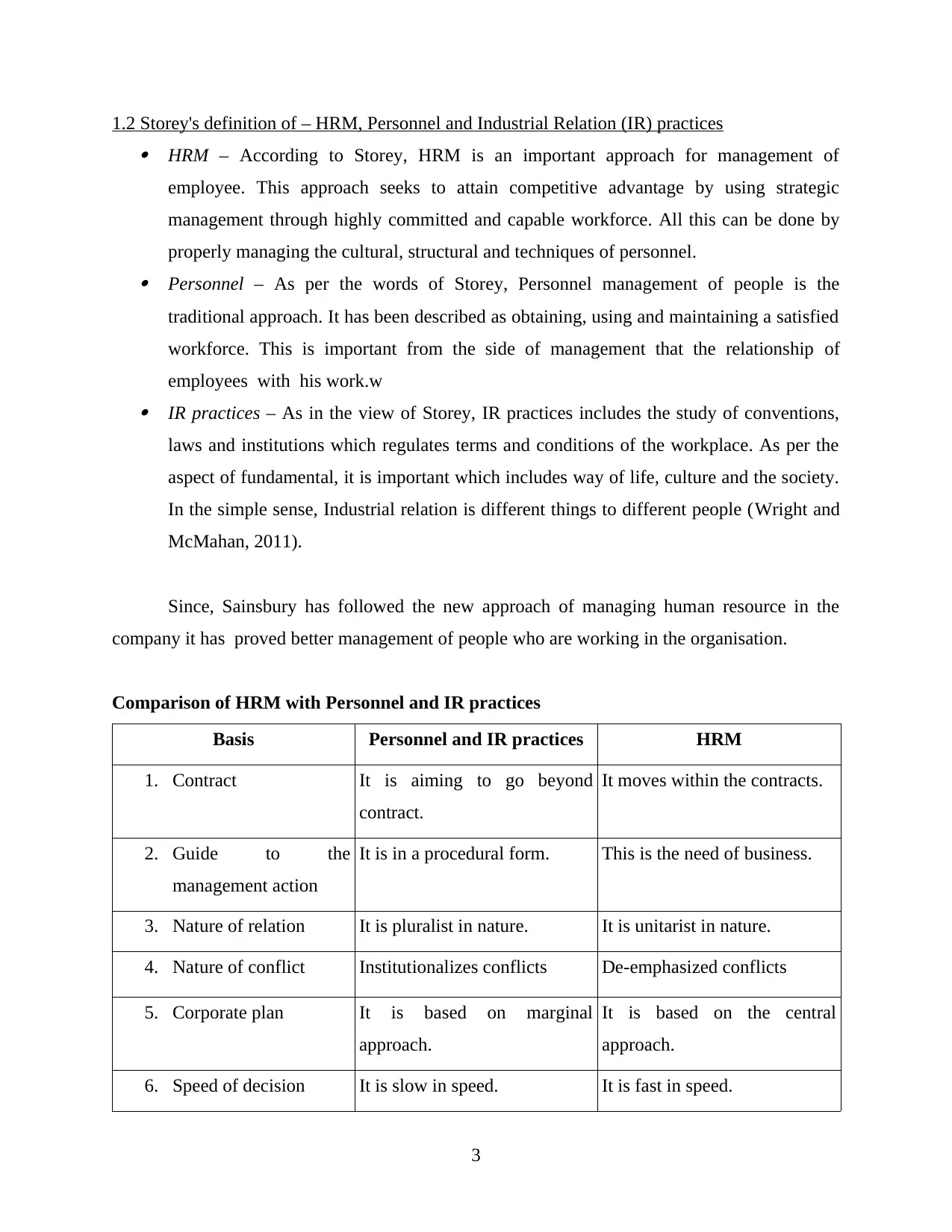
1.2 Storey's definition of – HRM, Personnel and Industrial Relation (IR) practices HRM – According to Storey, HRM is an important approach for management of
employee. This approach seeks to attain competitive advantage by using strategic
management through highly committed and capable workforce. All this can be done by
properly managing the cultural, structural and techniques of personnel. Personnel – As per the words of Storey, Personnel management of people is the
traditional approach. It has been described as obtaining, using and maintaining a satisfied
workforce. This is important from the side of management that the relationship of
employees with his work.w IR practices – As in the view of Storey, IR practices includes the study of conventions,
laws and institutions which regulates terms and conditions of the workplace. As per the
aspect of fundamental, it is important which includes way of life, culture and the society.
In the simple sense, Industrial relation is different things to different people (Wright and
McMahan, 2011).
Since, Sainsbury has followed the new approach of managing human resource in the
company it has proved better management of people who are working in the organisation.
Comparison of HRM with Personnel and IR practices
Basis Personnel and IR practices HRM
1. Contract It is aiming to go beyond
contract.
It moves within the contracts.
2. Guide to the
management action
It is in a procedural form. This is the need of business.
3. Nature of relation It is pluralist in nature. It is unitarist in nature.
4. Nature of conflict Institutionalizes conflicts De-emphasized conflicts
5. Corporate plan It is based on marginal
approach.
It is based on the central
approach.
6. Speed of decision It is slow in speed. It is fast in speed.
3
employee. This approach seeks to attain competitive advantage by using strategic
management through highly committed and capable workforce. All this can be done by
properly managing the cultural, structural and techniques of personnel. Personnel – As per the words of Storey, Personnel management of people is the
traditional approach. It has been described as obtaining, using and maintaining a satisfied
workforce. This is important from the side of management that the relationship of
employees with his work.w IR practices – As in the view of Storey, IR practices includes the study of conventions,
laws and institutions which regulates terms and conditions of the workplace. As per the
aspect of fundamental, it is important which includes way of life, culture and the society.
In the simple sense, Industrial relation is different things to different people (Wright and
McMahan, 2011).
Since, Sainsbury has followed the new approach of managing human resource in the
company it has proved better management of people who are working in the organisation.
Comparison of HRM with Personnel and IR practices
Basis Personnel and IR practices HRM
1. Contract It is aiming to go beyond
contract.
It moves within the contracts.
2. Guide to the
management action
It is in a procedural form. This is the need of business.
3. Nature of relation It is pluralist in nature. It is unitarist in nature.
4. Nature of conflict Institutionalizes conflicts De-emphasized conflicts
5. Corporate plan It is based on marginal
approach.
It is based on the central
approach.
6. Speed of decision It is slow in speed. It is fast in speed.
3
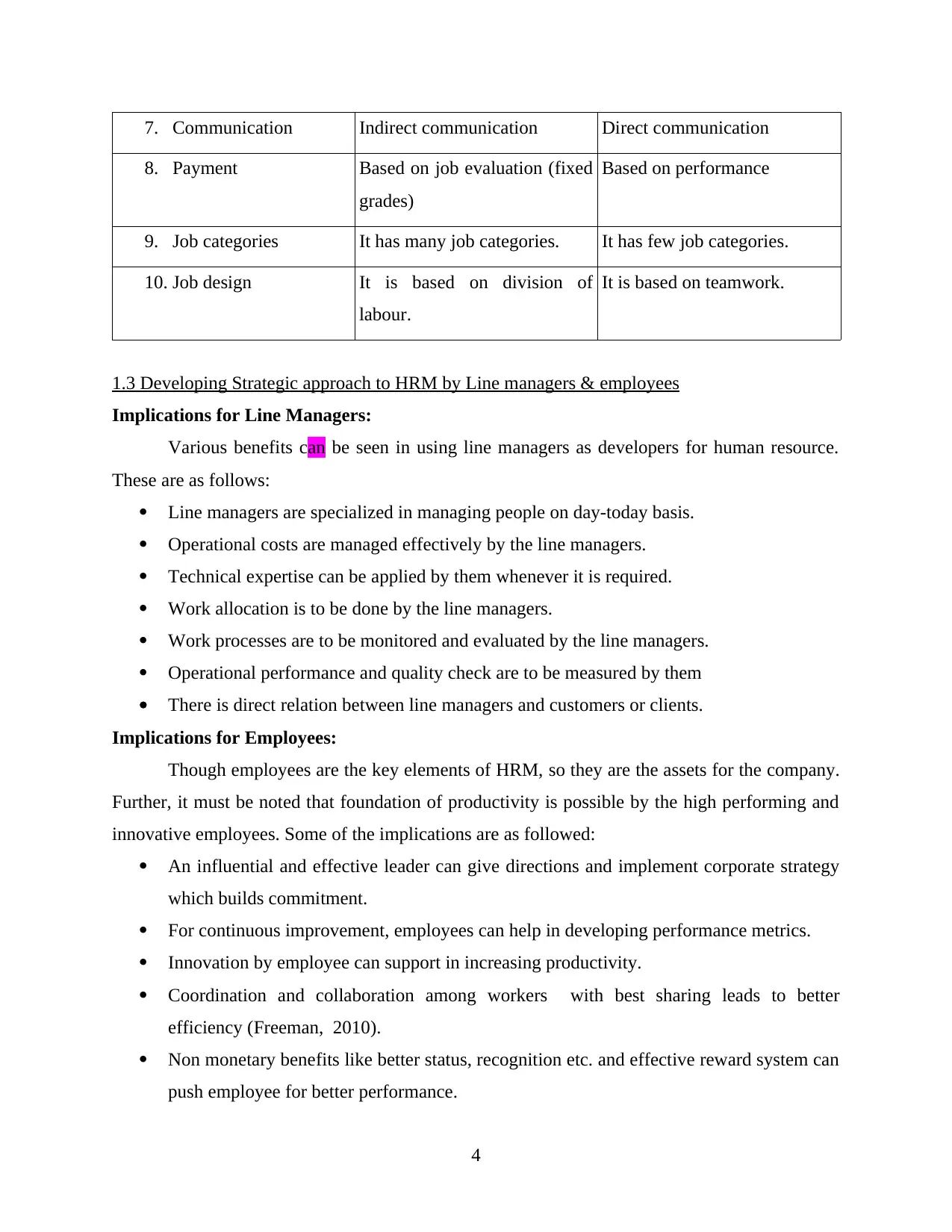
7. Communication Indirect communication Direct communication
8. Payment Based on job evaluation (fixed
grades)
Based on performance
9. Job categories It has many job categories. It has few job categories.
10. Job design It is based on division of
labour.
It is based on teamwork.
1.3 Developing Strategic approach to HRM by Line managers & employees
Implications for Line Managers:
Various benefits can be seen in using line managers as developers for human resource.
These are as follows:
Line managers are specialized in managing people on day-today basis.
Operational costs are managed effectively by the line managers.
Technical expertise can be applied by them whenever it is required.
Work allocation is to be done by the line managers.
Work processes are to be monitored and evaluated by the line managers.
Operational performance and quality check are to be measured by them
There is direct relation between line managers and customers or clients.
Implications for Employees:
Though employees are the key elements of HRM, so they are the assets for the company.
Further, it must be noted that foundation of productivity is possible by the high performing and
innovative employees. Some of the implications are as followed:
An influential and effective leader can give directions and implement corporate strategy
which builds commitment.
For continuous improvement, employees can help in developing performance metrics.
Innovation by employee can support in increasing productivity.
Coordination and collaboration among workers with best sharing leads to better
efficiency (Freeman, 2010).
Non monetary benefits like better status, recognition etc. and effective reward system can
push employee for better performance.
4
8. Payment Based on job evaluation (fixed
grades)
Based on performance
9. Job categories It has many job categories. It has few job categories.
10. Job design It is based on division of
labour.
It is based on teamwork.
1.3 Developing Strategic approach to HRM by Line managers & employees
Implications for Line Managers:
Various benefits can be seen in using line managers as developers for human resource.
These are as follows:
Line managers are specialized in managing people on day-today basis.
Operational costs are managed effectively by the line managers.
Technical expertise can be applied by them whenever it is required.
Work allocation is to be done by the line managers.
Work processes are to be monitored and evaluated by the line managers.
Operational performance and quality check are to be measured by them
There is direct relation between line managers and customers or clients.
Implications for Employees:
Though employees are the key elements of HRM, so they are the assets for the company.
Further, it must be noted that foundation of productivity is possible by the high performing and
innovative employees. Some of the implications are as followed:
An influential and effective leader can give directions and implement corporate strategy
which builds commitment.
For continuous improvement, employees can help in developing performance metrics.
Innovation by employee can support in increasing productivity.
Coordination and collaboration among workers with best sharing leads to better
efficiency (Freeman, 2010).
Non monetary benefits like better status, recognition etc. and effective reward system can
push employee for better performance.
4
⊘ This is a preview!⊘
Do you want full access?
Subscribe today to unlock all pages.

Trusted by 1+ million students worldwide
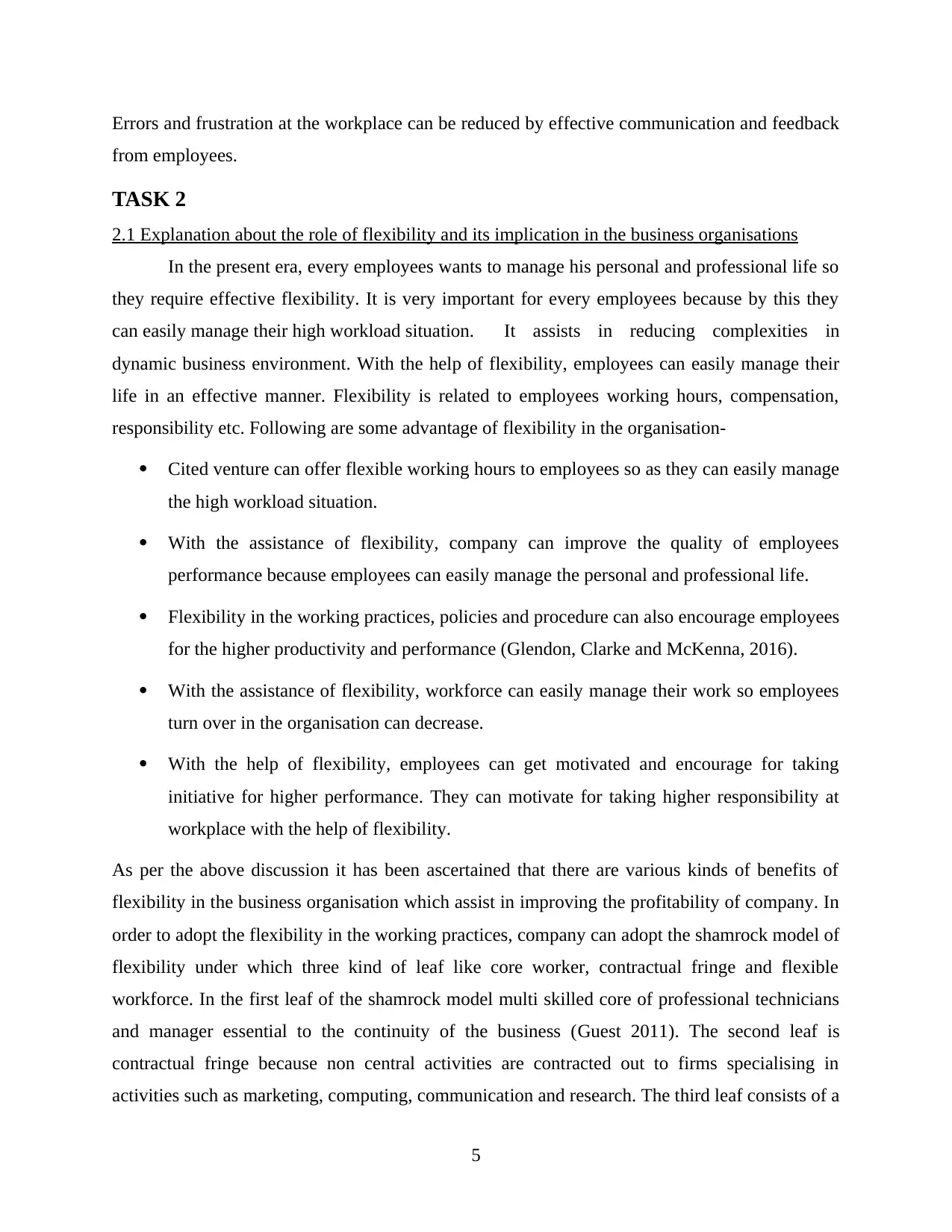
Errors and frustration at the workplace can be reduced by effective communication and feedback
from employees.
TASK 2
2.1 Explanation about the role of flexibility and its implication in the business organisations
In the present era, every employees wants to manage his personal and professional life so
they require effective flexibility. It is very important for every employees because by this they
can easily manage their high workload situation. It assists in reducing complexities in
dynamic business environment. With the help of flexibility, employees can easily manage their
life in an effective manner. Flexibility is related to employees working hours, compensation,
responsibility etc. Following are some advantage of flexibility in the organisation-
Cited venture can offer flexible working hours to employees so as they can easily manage
the high workload situation.
With the assistance of flexibility, company can improve the quality of employees
performance because employees can easily manage the personal and professional life.
Flexibility in the working practices, policies and procedure can also encourage employees
for the higher productivity and performance (Glendon, Clarke and McKenna, 2016).
With the assistance of flexibility, workforce can easily manage their work so employees
turn over in the organisation can decrease.
With the help of flexibility, employees can get motivated and encourage for taking
initiative for higher performance. They can motivate for taking higher responsibility at
workplace with the help of flexibility.
As per the above discussion it has been ascertained that there are various kinds of benefits of
flexibility in the business organisation which assist in improving the profitability of company. In
order to adopt the flexibility in the working practices, company can adopt the shamrock model of
flexibility under which three kind of leaf like core worker, contractual fringe and flexible
workforce. In the first leaf of the shamrock model multi skilled core of professional technicians
and manager essential to the continuity of the business (Guest 2011). The second leaf is
contractual fringe because non central activities are contracted out to firms specialising in
activities such as marketing, computing, communication and research. The third leaf consists of a
5
from employees.
TASK 2
2.1 Explanation about the role of flexibility and its implication in the business organisations
In the present era, every employees wants to manage his personal and professional life so
they require effective flexibility. It is very important for every employees because by this they
can easily manage their high workload situation. It assists in reducing complexities in
dynamic business environment. With the help of flexibility, employees can easily manage their
life in an effective manner. Flexibility is related to employees working hours, compensation,
responsibility etc. Following are some advantage of flexibility in the organisation-
Cited venture can offer flexible working hours to employees so as they can easily manage
the high workload situation.
With the assistance of flexibility, company can improve the quality of employees
performance because employees can easily manage the personal and professional life.
Flexibility in the working practices, policies and procedure can also encourage employees
for the higher productivity and performance (Glendon, Clarke and McKenna, 2016).
With the assistance of flexibility, workforce can easily manage their work so employees
turn over in the organisation can decrease.
With the help of flexibility, employees can get motivated and encourage for taking
initiative for higher performance. They can motivate for taking higher responsibility at
workplace with the help of flexibility.
As per the above discussion it has been ascertained that there are various kinds of benefits of
flexibility in the business organisation which assist in improving the profitability of company. In
order to adopt the flexibility in the working practices, company can adopt the shamrock model of
flexibility under which three kind of leaf like core worker, contractual fringe and flexible
workforce. In the first leaf of the shamrock model multi skilled core of professional technicians
and manager essential to the continuity of the business (Guest 2011). The second leaf is
contractual fringe because non central activities are contracted out to firms specialising in
activities such as marketing, computing, communication and research. The third leaf consists of a
5
Paraphrase This Document
Need a fresh take? Get an instant paraphrase of this document with our AI Paraphraser
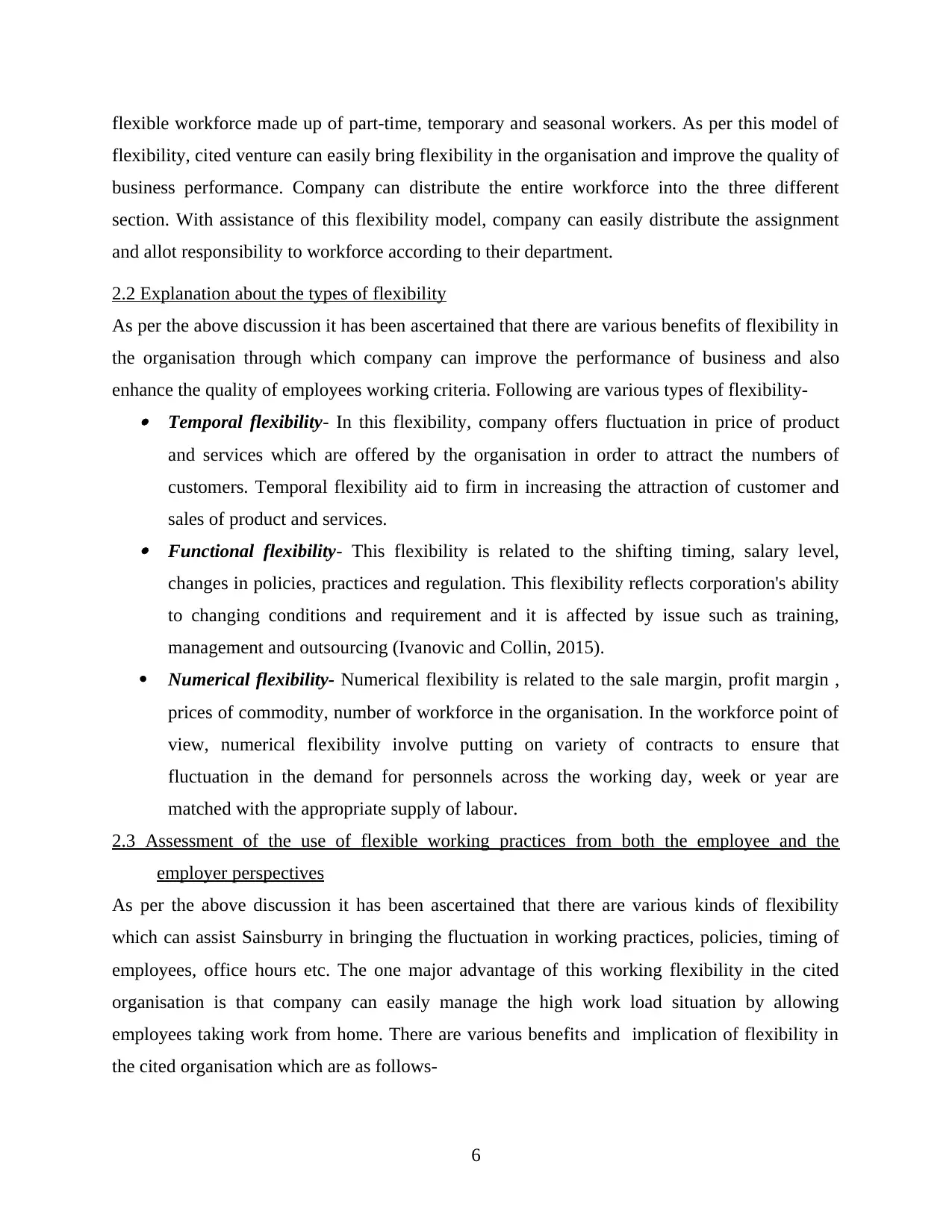
flexible workforce made up of part-time, temporary and seasonal workers. As per this model of
flexibility, cited venture can easily bring flexibility in the organisation and improve the quality of
business performance. Company can distribute the entire workforce into the three different
section. With assistance of this flexibility model, company can easily distribute the assignment
and allot responsibility to workforce according to their department.
2.2 Explanation about the types of flexibility
As per the above discussion it has been ascertained that there are various benefits of flexibility in
the organisation through which company can improve the performance of business and also
enhance the quality of employees working criteria. Following are various types of flexibility- Temporal flexibility- In this flexibility, company offers fluctuation in price of product
and services which are offered by the organisation in order to attract the numbers of
customers. Temporal flexibility aid to firm in increasing the attraction of customer and
sales of product and services. Functional flexibility- This flexibility is related to the shifting timing, salary level,
changes in policies, practices and regulation. This flexibility reflects corporation's ability
to changing conditions and requirement and it is affected by issue such as training,
management and outsourcing (Ivanovic and Collin, 2015).
Numerical flexibility- Numerical flexibility is related to the sale margin, profit margin ,
prices of commodity, number of workforce in the organisation. In the workforce point of
view, numerical flexibility involve putting on variety of contracts to ensure that
fluctuation in the demand for personnels across the working day, week or year are
matched with the appropriate supply of labour.
2.3 Assessment of the use of flexible working practices from both the employee and the
employer perspectives
As per the above discussion it has been ascertained that there are various kinds of flexibility
which can assist Sainsburry in bringing the fluctuation in working practices, policies, timing of
employees, office hours etc. The one major advantage of this working flexibility in the cited
organisation is that company can easily manage the high work load situation by allowing
employees taking work from home. There are various benefits and implication of flexibility in
the cited organisation which are as follows-
6
flexibility, cited venture can easily bring flexibility in the organisation and improve the quality of
business performance. Company can distribute the entire workforce into the three different
section. With assistance of this flexibility model, company can easily distribute the assignment
and allot responsibility to workforce according to their department.
2.2 Explanation about the types of flexibility
As per the above discussion it has been ascertained that there are various benefits of flexibility in
the organisation through which company can improve the performance of business and also
enhance the quality of employees working criteria. Following are various types of flexibility- Temporal flexibility- In this flexibility, company offers fluctuation in price of product
and services which are offered by the organisation in order to attract the numbers of
customers. Temporal flexibility aid to firm in increasing the attraction of customer and
sales of product and services. Functional flexibility- This flexibility is related to the shifting timing, salary level,
changes in policies, practices and regulation. This flexibility reflects corporation's ability
to changing conditions and requirement and it is affected by issue such as training,
management and outsourcing (Ivanovic and Collin, 2015).
Numerical flexibility- Numerical flexibility is related to the sale margin, profit margin ,
prices of commodity, number of workforce in the organisation. In the workforce point of
view, numerical flexibility involve putting on variety of contracts to ensure that
fluctuation in the demand for personnels across the working day, week or year are
matched with the appropriate supply of labour.
2.3 Assessment of the use of flexible working practices from both the employee and the
employer perspectives
As per the above discussion it has been ascertained that there are various kinds of flexibility
which can assist Sainsburry in bringing the fluctuation in working practices, policies, timing of
employees, office hours etc. The one major advantage of this working flexibility in the cited
organisation is that company can easily manage the high work load situation by allowing
employees taking work from home. There are various benefits and implication of flexibility in
the cited organisation which are as follows-
6
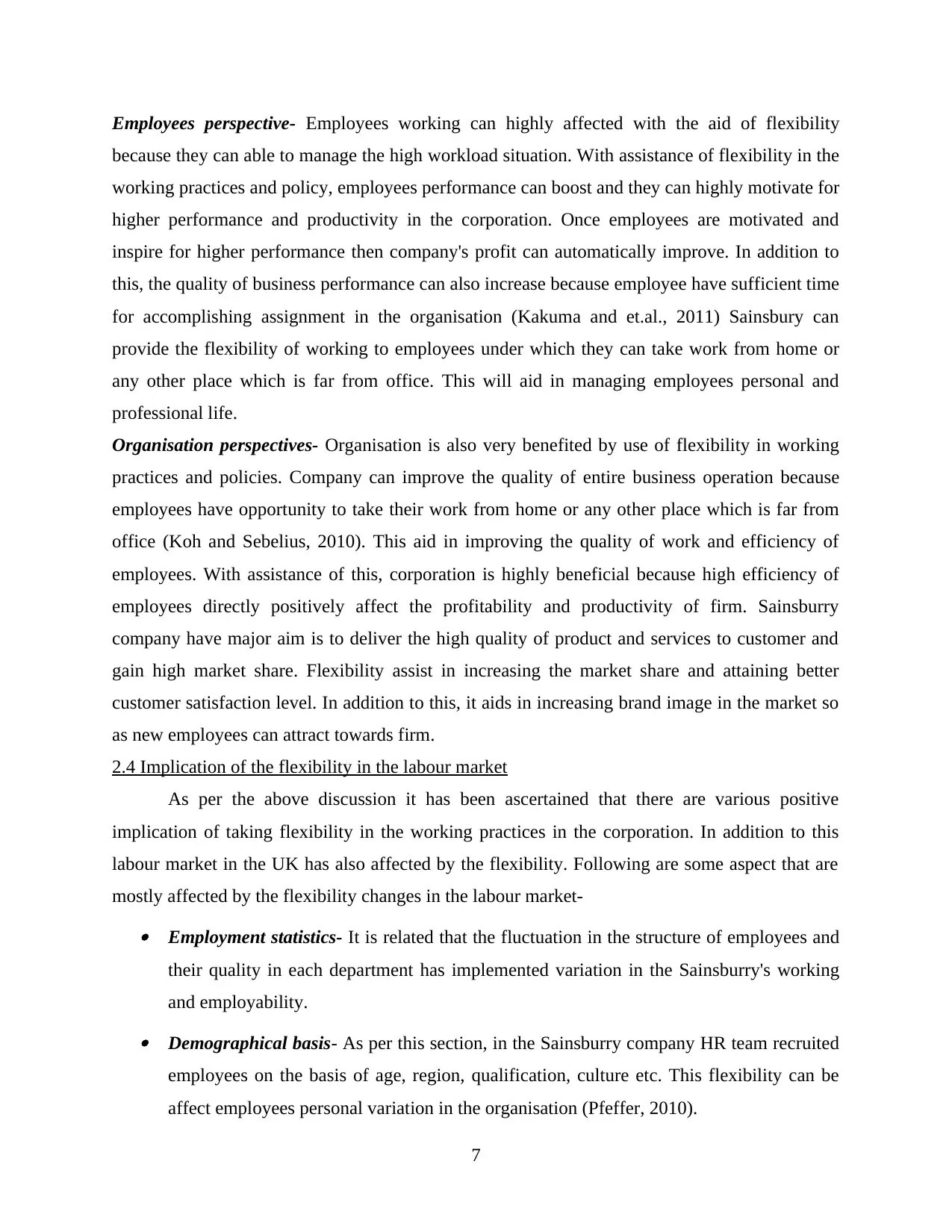
Employees perspective- Employees working can highly affected with the aid of flexibility
because they can able to manage the high workload situation. With assistance of flexibility in the
working practices and policy, employees performance can boost and they can highly motivate for
higher performance and productivity in the corporation. Once employees are motivated and
inspire for higher performance then company's profit can automatically improve. In addition to
this, the quality of business performance can also increase because employee have sufficient time
for accomplishing assignment in the organisation (Kakuma and et.al., 2011) Sainsbury can
provide the flexibility of working to employees under which they can take work from home or
any other place which is far from office. This will aid in managing employees personal and
professional life.
Organisation perspectives- Organisation is also very benefited by use of flexibility in working
practices and policies. Company can improve the quality of entire business operation because
employees have opportunity to take their work from home or any other place which is far from
office (Koh and Sebelius, 2010). This aid in improving the quality of work and efficiency of
employees. With assistance of this, corporation is highly beneficial because high efficiency of
employees directly positively affect the profitability and productivity of firm. Sainsburry
company have major aim is to deliver the high quality of product and services to customer and
gain high market share. Flexibility assist in increasing the market share and attaining better
customer satisfaction level. In addition to this, it aids in increasing brand image in the market so
as new employees can attract towards firm.
2.4 Implication of the flexibility in the labour market
As per the above discussion it has been ascertained that there are various positive
implication of taking flexibility in the working practices in the corporation. In addition to this
labour market in the UK has also affected by the flexibility. Following are some aspect that are
mostly affected by the flexibility changes in the labour market- Employment statistics- It is related that the fluctuation in the structure of employees and
their quality in each department has implemented variation in the Sainsburry's working
and employability. Demographical basis- As per this section, in the Sainsburry company HR team recruited
employees on the basis of age, region, qualification, culture etc. This flexibility can be
affect employees personal variation in the organisation (Pfeffer, 2010).
7
because they can able to manage the high workload situation. With assistance of flexibility in the
working practices and policy, employees performance can boost and they can highly motivate for
higher performance and productivity in the corporation. Once employees are motivated and
inspire for higher performance then company's profit can automatically improve. In addition to
this, the quality of business performance can also increase because employee have sufficient time
for accomplishing assignment in the organisation (Kakuma and et.al., 2011) Sainsbury can
provide the flexibility of working to employees under which they can take work from home or
any other place which is far from office. This will aid in managing employees personal and
professional life.
Organisation perspectives- Organisation is also very benefited by use of flexibility in working
practices and policies. Company can improve the quality of entire business operation because
employees have opportunity to take their work from home or any other place which is far from
office (Koh and Sebelius, 2010). This aid in improving the quality of work and efficiency of
employees. With assistance of this, corporation is highly beneficial because high efficiency of
employees directly positively affect the profitability and productivity of firm. Sainsburry
company have major aim is to deliver the high quality of product and services to customer and
gain high market share. Flexibility assist in increasing the market share and attaining better
customer satisfaction level. In addition to this, it aids in increasing brand image in the market so
as new employees can attract towards firm.
2.4 Implication of the flexibility in the labour market
As per the above discussion it has been ascertained that there are various positive
implication of taking flexibility in the working practices in the corporation. In addition to this
labour market in the UK has also affected by the flexibility. Following are some aspect that are
mostly affected by the flexibility changes in the labour market- Employment statistics- It is related that the fluctuation in the structure of employees and
their quality in each department has implemented variation in the Sainsburry's working
and employability. Demographical basis- As per this section, in the Sainsburry company HR team recruited
employees on the basis of age, region, qualification, culture etc. This flexibility can be
affect employees personal variation in the organisation (Pfeffer, 2010).
7
⊘ This is a preview!⊘
Do you want full access?
Subscribe today to unlock all pages.

Trusted by 1+ million students worldwide
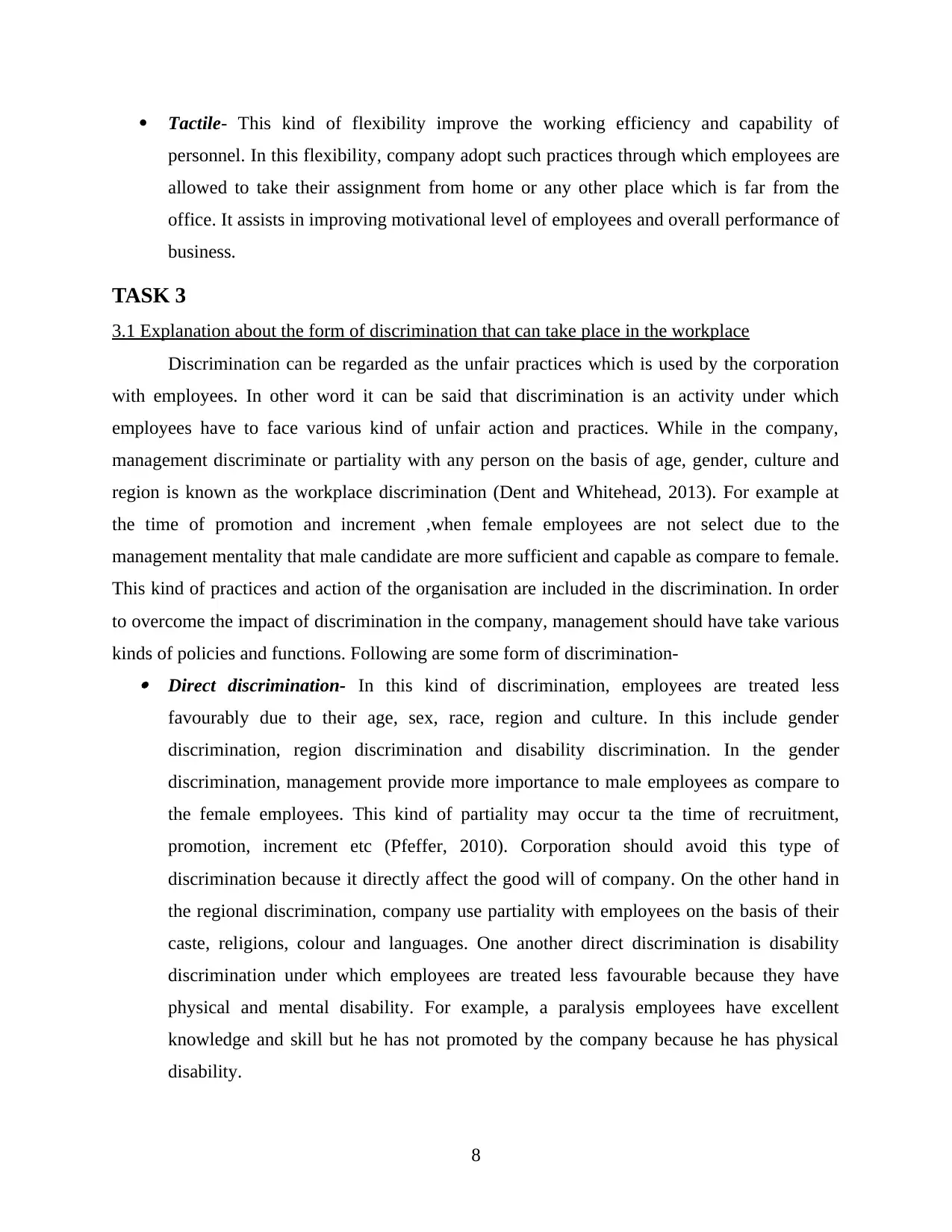
Tactile- This kind of flexibility improve the working efficiency and capability of
personnel. In this flexibility, company adopt such practices through which employees are
allowed to take their assignment from home or any other place which is far from the
office. It assists in improving motivational level of employees and overall performance of
business.
TASK 3
3.1 Explanation about the form of discrimination that can take place in the workplace
Discrimination can be regarded as the unfair practices which is used by the corporation
with employees. In other word it can be said that discrimination is an activity under which
employees have to face various kind of unfair action and practices. While in the company,
management discriminate or partiality with any person on the basis of age, gender, culture and
region is known as the workplace discrimination (Dent and Whitehead, 2013). For example at
the time of promotion and increment ,when female employees are not select due to the
management mentality that male candidate are more sufficient and capable as compare to female.
This kind of practices and action of the organisation are included in the discrimination. In order
to overcome the impact of discrimination in the company, management should have take various
kinds of policies and functions. Following are some form of discrimination- Direct discrimination- In this kind of discrimination, employees are treated less
favourably due to their age, sex, race, region and culture. In this include gender
discrimination, region discrimination and disability discrimination. In the gender
discrimination, management provide more importance to male employees as compare to
the female employees. This kind of partiality may occur ta the time of recruitment,
promotion, increment etc (Pfeffer, 2010). Corporation should avoid this type of
discrimination because it directly affect the good will of company. On the other hand in
the regional discrimination, company use partiality with employees on the basis of their
caste, religions, colour and languages. One another direct discrimination is disability
discrimination under which employees are treated less favourable because they have
physical and mental disability. For example, a paralysis employees have excellent
knowledge and skill but he has not promoted by the company because he has physical
disability.
8
personnel. In this flexibility, company adopt such practices through which employees are
allowed to take their assignment from home or any other place which is far from the
office. It assists in improving motivational level of employees and overall performance of
business.
TASK 3
3.1 Explanation about the form of discrimination that can take place in the workplace
Discrimination can be regarded as the unfair practices which is used by the corporation
with employees. In other word it can be said that discrimination is an activity under which
employees have to face various kind of unfair action and practices. While in the company,
management discriminate or partiality with any person on the basis of age, gender, culture and
region is known as the workplace discrimination (Dent and Whitehead, 2013). For example at
the time of promotion and increment ,when female employees are not select due to the
management mentality that male candidate are more sufficient and capable as compare to female.
This kind of practices and action of the organisation are included in the discrimination. In order
to overcome the impact of discrimination in the company, management should have take various
kinds of policies and functions. Following are some form of discrimination- Direct discrimination- In this kind of discrimination, employees are treated less
favourably due to their age, sex, race, region and culture. In this include gender
discrimination, region discrimination and disability discrimination. In the gender
discrimination, management provide more importance to male employees as compare to
the female employees. This kind of partiality may occur ta the time of recruitment,
promotion, increment etc (Pfeffer, 2010). Corporation should avoid this type of
discrimination because it directly affect the good will of company. On the other hand in
the regional discrimination, company use partiality with employees on the basis of their
caste, religions, colour and languages. One another direct discrimination is disability
discrimination under which employees are treated less favourable because they have
physical and mental disability. For example, a paralysis employees have excellent
knowledge and skill but he has not promoted by the company because he has physical
disability.
8
Paraphrase This Document
Need a fresh take? Get an instant paraphrase of this document with our AI Paraphraser
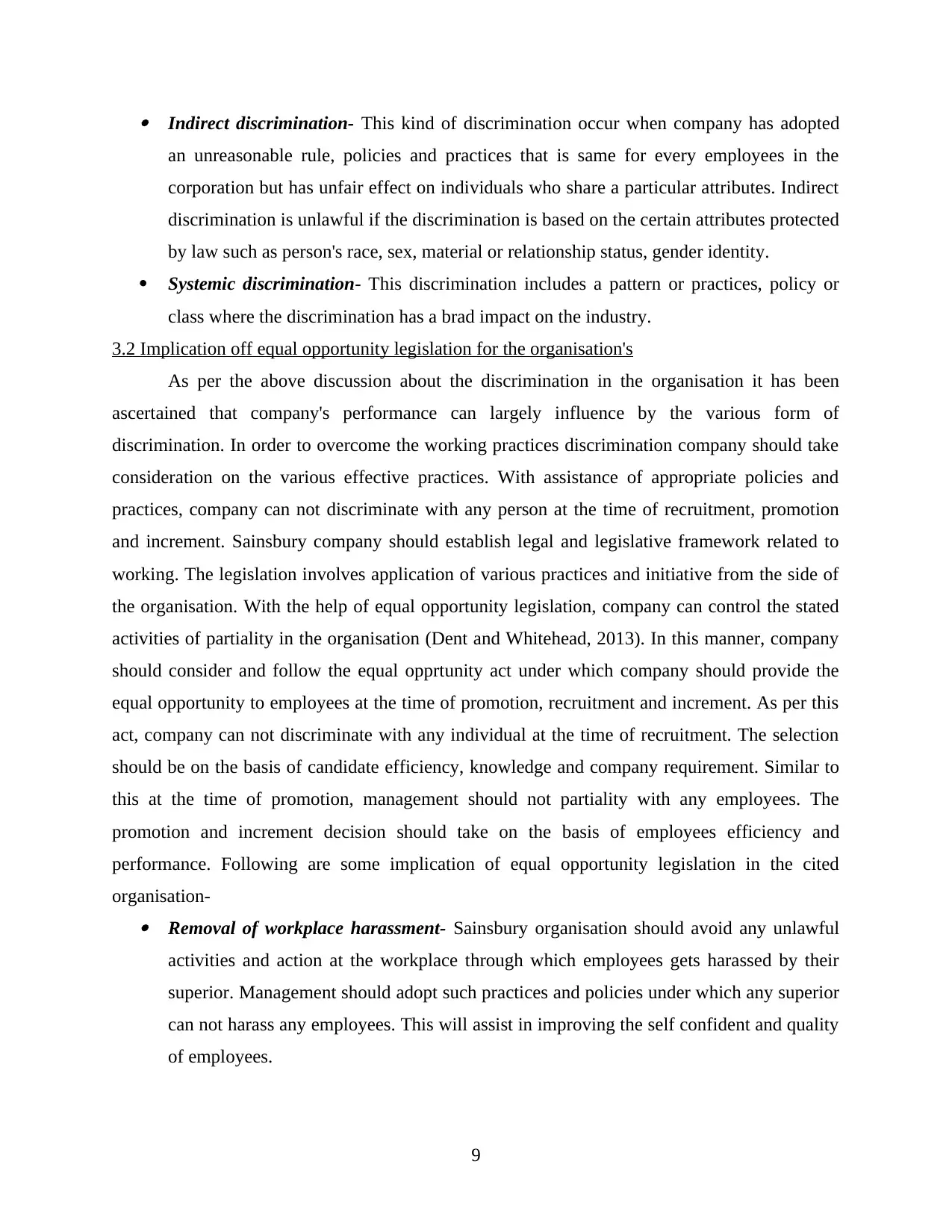
Indirect discrimination- This kind of discrimination occur when company has adopted
an unreasonable rule, policies and practices that is same for every employees in the
corporation but has unfair effect on individuals who share a particular attributes. Indirect
discrimination is unlawful if the discrimination is based on the certain attributes protected
by law such as person's race, sex, material or relationship status, gender identity.
Systemic discrimination- This discrimination includes a pattern or practices, policy or
class where the discrimination has a brad impact on the industry.
3.2 Implication off equal opportunity legislation for the organisation's
As per the above discussion about the discrimination in the organisation it has been
ascertained that company's performance can largely influence by the various form of
discrimination. In order to overcome the working practices discrimination company should take
consideration on the various effective practices. With assistance of appropriate policies and
practices, company can not discriminate with any person at the time of recruitment, promotion
and increment. Sainsbury company should establish legal and legislative framework related to
working. The legislation involves application of various practices and initiative from the side of
the organisation. With the help of equal opportunity legislation, company can control the stated
activities of partiality in the organisation (Dent and Whitehead, 2013). In this manner, company
should consider and follow the equal opprtunity act under which company should provide the
equal opportunity to employees at the time of promotion, recruitment and increment. As per this
act, company can not discriminate with any individual at the time of recruitment. The selection
should be on the basis of candidate efficiency, knowledge and company requirement. Similar to
this at the time of promotion, management should not partiality with any employees. The
promotion and increment decision should take on the basis of employees efficiency and
performance. Following are some implication of equal opportunity legislation in the cited
organisation- Removal of workplace harassment- Sainsbury organisation should avoid any unlawful
activities and action at the workplace through which employees gets harassed by their
superior. Management should adopt such practices and policies under which any superior
can not harass any employees. This will assist in improving the self confident and quality
of employees.
9
an unreasonable rule, policies and practices that is same for every employees in the
corporation but has unfair effect on individuals who share a particular attributes. Indirect
discrimination is unlawful if the discrimination is based on the certain attributes protected
by law such as person's race, sex, material or relationship status, gender identity.
Systemic discrimination- This discrimination includes a pattern or practices, policy or
class where the discrimination has a brad impact on the industry.
3.2 Implication off equal opportunity legislation for the organisation's
As per the above discussion about the discrimination in the organisation it has been
ascertained that company's performance can largely influence by the various form of
discrimination. In order to overcome the working practices discrimination company should take
consideration on the various effective practices. With assistance of appropriate policies and
practices, company can not discriminate with any person at the time of recruitment, promotion
and increment. Sainsbury company should establish legal and legislative framework related to
working. The legislation involves application of various practices and initiative from the side of
the organisation. With the help of equal opportunity legislation, company can control the stated
activities of partiality in the organisation (Dent and Whitehead, 2013). In this manner, company
should consider and follow the equal opprtunity act under which company should provide the
equal opportunity to employees at the time of promotion, recruitment and increment. As per this
act, company can not discriminate with any individual at the time of recruitment. The selection
should be on the basis of candidate efficiency, knowledge and company requirement. Similar to
this at the time of promotion, management should not partiality with any employees. The
promotion and increment decision should take on the basis of employees efficiency and
performance. Following are some implication of equal opportunity legislation in the cited
organisation- Removal of workplace harassment- Sainsbury organisation should avoid any unlawful
activities and action at the workplace through which employees gets harassed by their
superior. Management should adopt such practices and policies under which any superior
can not harass any employees. This will assist in improving the self confident and quality
of employees.
9
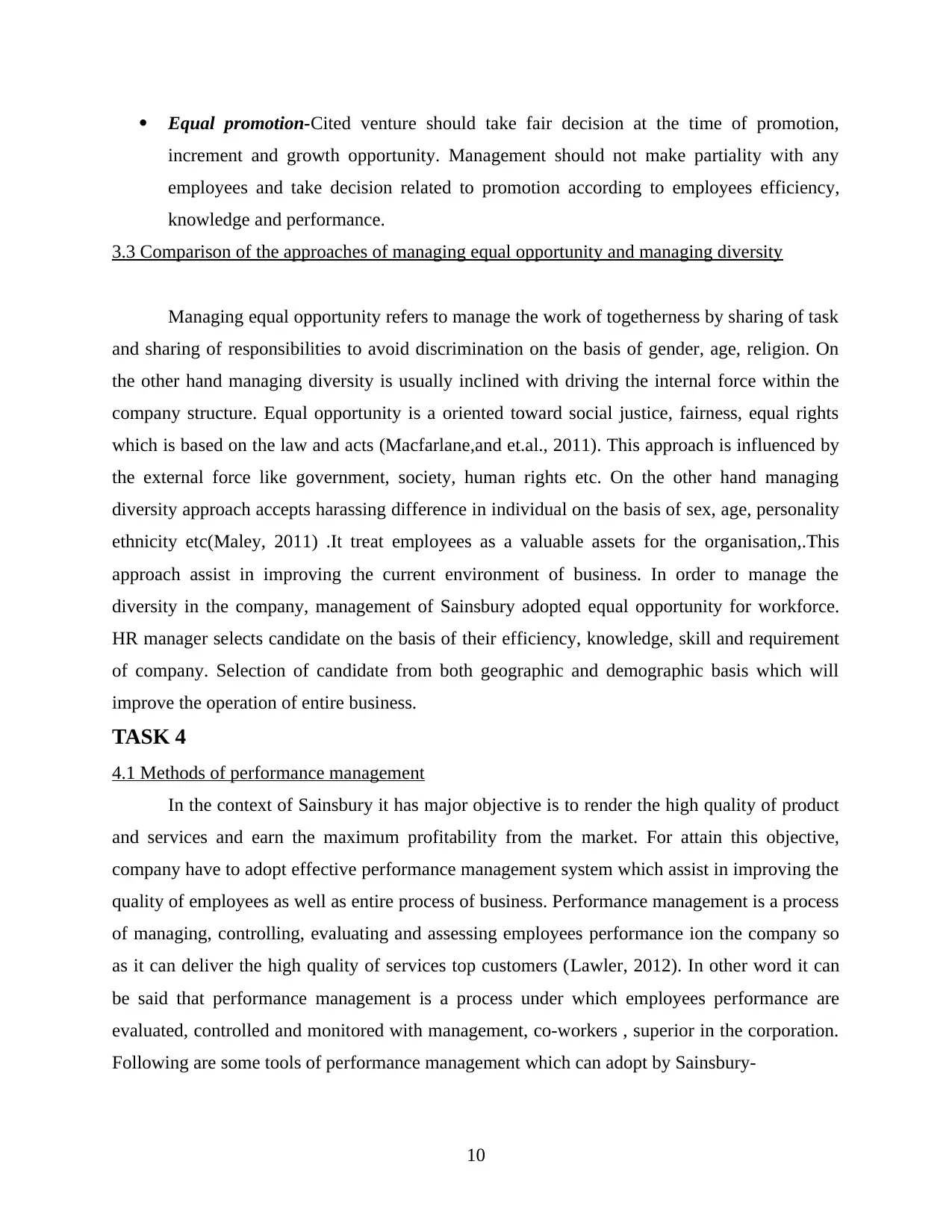
Equal promotion-Cited venture should take fair decision at the time of promotion,
increment and growth opportunity. Management should not make partiality with any
employees and take decision related to promotion according to employees efficiency,
knowledge and performance.
3.3 Comparison of the approaches of managing equal opportunity and managing diversity
Managing equal opportunity refers to manage the work of togetherness by sharing of task
and sharing of responsibilities to avoid discrimination on the basis of gender, age, religion. On
the other hand managing diversity is usually inclined with driving the internal force within the
company structure. Equal opportunity is a oriented toward social justice, fairness, equal rights
which is based on the law and acts (Macfarlane,and et.al., 2011). This approach is influenced by
the external force like government, society, human rights etc. On the other hand managing
diversity approach accepts harassing difference in individual on the basis of sex, age, personality
ethnicity etc(Maley, 2011) .It treat employees as a valuable assets for the organisation,.This
approach assist in improving the current environment of business. In order to manage the
diversity in the company, management of Sainsbury adopted equal opportunity for workforce.
HR manager selects candidate on the basis of their efficiency, knowledge, skill and requirement
of company. Selection of candidate from both geographic and demographic basis which will
improve the operation of entire business.
TASK 4
4.1 Methods of performance management
In the context of Sainsbury it has major objective is to render the high quality of product
and services and earn the maximum profitability from the market. For attain this objective,
company have to adopt effective performance management system which assist in improving the
quality of employees as well as entire process of business. Performance management is a process
of managing, controlling, evaluating and assessing employees performance ion the company so
as it can deliver the high quality of services top customers (Lawler, 2012). In other word it can
be said that performance management is a process under which employees performance are
evaluated, controlled and monitored with management, co-workers , superior in the corporation.
Following are some tools of performance management which can adopt by Sainsbury-
10
increment and growth opportunity. Management should not make partiality with any
employees and take decision related to promotion according to employees efficiency,
knowledge and performance.
3.3 Comparison of the approaches of managing equal opportunity and managing diversity
Managing equal opportunity refers to manage the work of togetherness by sharing of task
and sharing of responsibilities to avoid discrimination on the basis of gender, age, religion. On
the other hand managing diversity is usually inclined with driving the internal force within the
company structure. Equal opportunity is a oriented toward social justice, fairness, equal rights
which is based on the law and acts (Macfarlane,and et.al., 2011). This approach is influenced by
the external force like government, society, human rights etc. On the other hand managing
diversity approach accepts harassing difference in individual on the basis of sex, age, personality
ethnicity etc(Maley, 2011) .It treat employees as a valuable assets for the organisation,.This
approach assist in improving the current environment of business. In order to manage the
diversity in the company, management of Sainsbury adopted equal opportunity for workforce.
HR manager selects candidate on the basis of their efficiency, knowledge, skill and requirement
of company. Selection of candidate from both geographic and demographic basis which will
improve the operation of entire business.
TASK 4
4.1 Methods of performance management
In the context of Sainsbury it has major objective is to render the high quality of product
and services and earn the maximum profitability from the market. For attain this objective,
company have to adopt effective performance management system which assist in improving the
quality of employees as well as entire process of business. Performance management is a process
of managing, controlling, evaluating and assessing employees performance ion the company so
as it can deliver the high quality of services top customers (Lawler, 2012). In other word it can
be said that performance management is a process under which employees performance are
evaluated, controlled and monitored with management, co-workers , superior in the corporation.
Following are some tools of performance management which can adopt by Sainsbury-
10
⊘ This is a preview!⊘
Do you want full access?
Subscribe today to unlock all pages.

Trusted by 1+ million students worldwide
1 out of 18
Related Documents
Your All-in-One AI-Powered Toolkit for Academic Success.
+13062052269
info@desklib.com
Available 24*7 on WhatsApp / Email
![[object Object]](/_next/static/media/star-bottom.7253800d.svg)
Unlock your academic potential
Copyright © 2020–2025 A2Z Services. All Rights Reserved. Developed and managed by ZUCOL.





